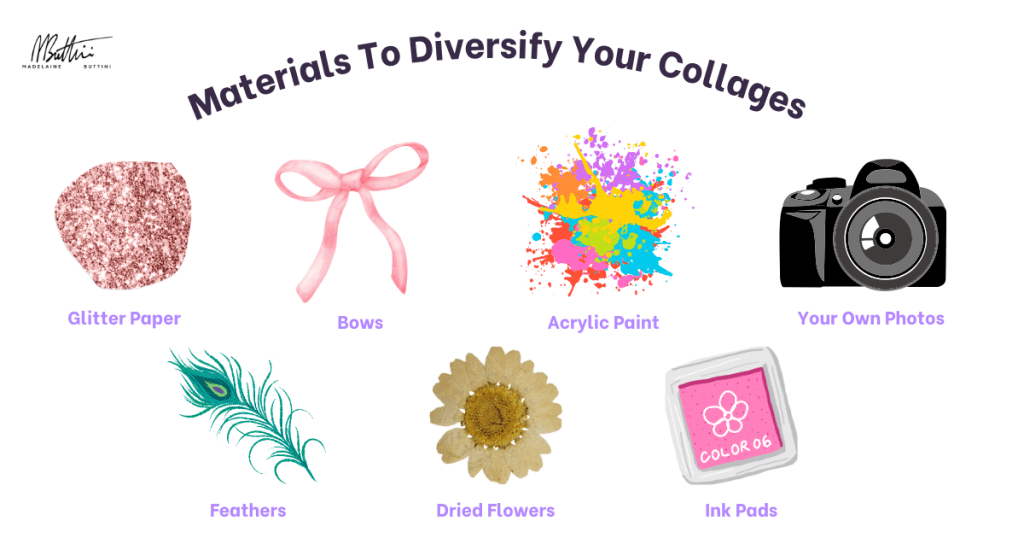Collage art is a versatile and captivating form of art. From the beginnings of collage, it has thrived on experimentation with various materials. In this blog post, I will give you ten materials to try for your next creation!
Want more blog posts like these? Check these other ones out after you’ve finished reading…
- The Influence of Cultural Diversity in Collage Art
- Collage Art Challenges: Join the Community and Get Inspired!
We all know about magazines and other found materials for collage art, but have you thought about diversifying your creations? You can incorporate fabric, textured paper, or paints to introduce a tactile elements. These will engage not just the eyes but also a sense of touch thus creating a multi-dimensional experience.
Using a variety of materials allows artists to create unique and original compositions. Try mixing unconventional items or textures that aren’t typically associated with art. This can set your work apart, making it distinctive and memorable!
Each material carries its own history and context, by incorporating diverse materials, artists can weave stories and narratives into their collages. Elevate your collage game with these ten must-try materials that promise to enhance your creations and bring your artistic vision to life!
Assorted Papers and Textures
Gather an array of papers: vintage magazines, textured card stock, handmade paper, or even old book pages. Mix and match textures and colours for depth and contrast in your collages. I remember in 2016, I loved using glitter paper for a series of works I exhibited! I found it to be so much fun to make different shapes.
Fabric Scraps
Explore the world of textiles by incorporating fabric scraps. From lace to denim and everything in between, these materials introduce unique textures and patterns to your artwork. I like to suggest having amore sustainable approach to purchasing materials. I would first suggest going to places such as thrift shops or Reverse Garabage if you’re in Queensland.
Found Objects
You can venture beyond traditional materials by integrating found objects. These might be things such as buttons, keys, or natural elements such as leaves and feathers. These items add a touch of uniqueness to your collages. You can make it a mental health activity and go for a walk to see what you can find on your adventure!
Acrylic Paints
I already experiment with acrylic paints within my own artworks. I find this to be so much fun and an epic way to diversify my collages. As a material for collage art, I find acrylic paints to be a soothing way to express myself. You can create backgrounds or add accents to your collages. They offer versatility in terms of colour mixing and layering. This is a great time to get a colour wheel to help you learn colour theory, I have one in my studio!
Washi Tape
Washi tape is not just for paper crafts; it’s a fantastic addition to collage art. Its varied patterns and easy application allow for precise detailing. You can purchase Washi Tape here.
Photographs
This is something I am most excited to learn about and explore. I think adding photographs you have taken into collage art as a material is really fantastic. I would incorporate personal or printed photographs into my collages. It will add a narrative element and make the artwork more sentimental.
7. Stamps and Ink Pads
Much like with acrylic paint, ink is a great material for collage art. When I do lino printing on my collage works, I feel it adds a new depth and layer to the final artwork – something I am always striving for when I make collages these days. Start by explore the world of stamping to create unique patterns or add intricate details to your collages using different ink colours and stamp designs.
8. Embellishments
Enhance your collages with embellishments like sequins, beads, or rhinestones for a touch of sparkle and dimension. Again… please try to be as eco-conscious as you can when you are selecting collage materials. Be aware of plastic and your buyer habits! Head to your thrift stores to see what they have on offer before purchasing something new.
9. Gel Medium or Mod Podge
Depending on what glue you are using having a strong adhesive mediums is essential for collage-making. You can use gel mediums to provide a protective layer, just remember that it might reactive certain inks.
10. Digital Elements
Combine traditional and digital art by incorporating digital elements like scanned images or digital drawings into your collage compositions. It’s a fun way to develop and diversify your materials for collage art. Launching you into success for exhibitions!
Tips for Using These Materials:
- Experimentation is key; don’t be afraid to try unconventional combinations.
- Always consider your brand ethos, the theme or message you want to convey. For instance, you wouldn’t want to be an eco-conscious artist and purchase lots of plastic materials straight from a factory, source it from other locations first.
- Create a focal point by layering materials strategically.
- Invest time in organising and categorising your materials to streamline the creative process.
These ten materials open up a world of possibilities in the realm of collage art. Embrace experimentation and allow your creativity to flow freely. With these tools at your disposal, you’re equipped to craft stunning and expressive collage creations that captivate the eyes and minds of your audience.
To learn more about collage techniques and explore inspirational ideas, stay tuned to our blog for upcoming articles!

